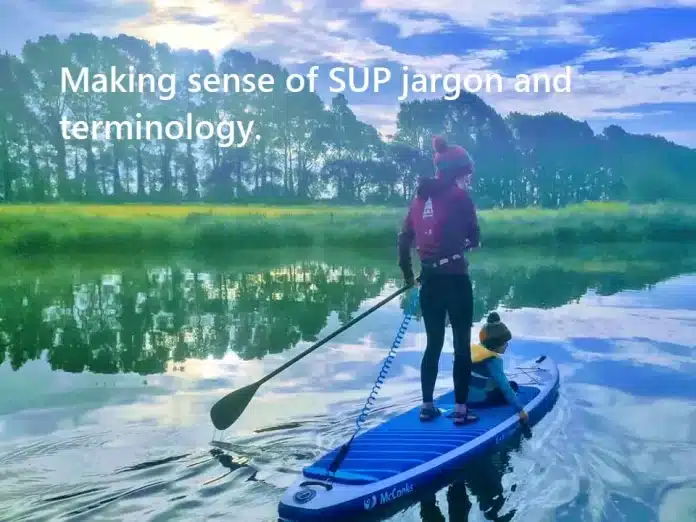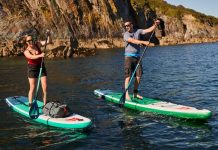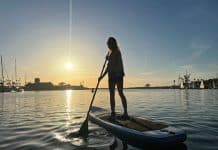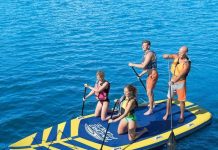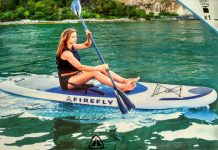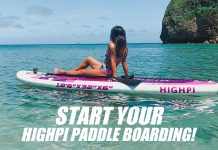You will not find much when you first look at a stand-up paddleboard. It is a slightly curved board-like construction with fins placed on the bottom.
The SUP looks just like a longboard usually used in surfing or anything like that.
Although a few of the components and terminology are pretty much the same as the surfboards, there are different mechanisms on the stand-up paddleboard that every paddler must know.
Among the first steps before starting your paddleboarding journey is to learn its terminology, glossary, and explanations.
Here we made a complete list and explanation of the different glossaries referring to the vital parts of the stand-up paddleboard and their general function.
Stand-Up Paddleboard (SUP) Glossary And Explanations
The SUP or stand-up paddleboard came as a cross between a canoe and a surfboard. The terminology used consequently comes from both of them. So, here are the utmost frequently used languages.
All-Around Board:
All-around paddleboards (usually called “all-arounders”) are pretty understandable. These paddleboards are intended for maximum, if not all, stand-up paddleboard conditions. It may include chop, waves, and also flat water.
They’re usually longer, from 10 to 12 feet long, 29 inches to 36 inches wider, and 4 to 6 inches thicker, more steady, and appropriate for beginner paddlers. These paddleboards are great for paddleboarding closer to the coastline and recreational drives.
Nevertheless, within this category, some paddleboards are more suitable for beginners, surfboards, fitness, advanced paddlers, and more. However, it is not ideal as a touring board.
Paddle Blade
This’s the wide, flat part of a SUP paddle that goes into the water to help you drive the board. A wide paddle blade is powerful but needs better use of your upper-body joints.
On the other hand, a narrow blade is gentler and allows you to paddle at a better rate (which means more paddle strokes within less time).
The V-shaped paddle blades are steady throughout paddleboarding and not very powerful (drives the water away.
And hollow paddle blades are way more powerful. However, they need an excellent paddleboarding technique to control them.
Read Next – SOOPOTAY Inflatable SUP Stand-UP Paddle
Bottom Turn
The bottom turn in stand-up paddleboard is a decisive, smooth turn at the bottom of the surf that converts vertical energy (grew by dropping the surf) into parallel power (rotating at the bottom) in such a way that offers you the proper direction and speed for a better maneuver on the wave.
Backside
When you paddle through a wave on a side, but with you, place your back to the wave and turn on the heel side.
The paddleboarding this block is way more problematic than frontside since you feel less balanced on the heel side with the back placed to the wave.
Buoyancy Aid
The buoyancy aid reduces the risk of sinking; however, it doesn’t guarantee lifesaving. It’s intended for strong paddleboarders close to a shore or bank or who help and assist nearby.
The buoyancy aids are mainly used for dinghy sailing, kayaking, and SUP boarding, but kids under 30kg or non-swimmer adults must not use them. It’s less beneficial in choppy waters. It can’t protect the paddleboarder in case they fall unconscious.
Clamp
This’s the adjustment structure for the flexible part of the adjustable paddles. This structure uses a “pushpin” (a pin enters the hole to lock the paddle shaft at your desired length). It is durable but not easy to use.
Bow
This bulging part procedure the nose of a SUP, mostly on racing paddleboards.
Cross-Bow
While paddling backside, the paddle stays on the wave side throughout the bottom turn. As soon as the paddler climbs up the surf to make the top turn, they transfer the paddle to another side of the paddleboard, passing it over the board’s nose without changing hands and turning the shoulders down the surf, and plant it on the side reverses the wave.
This cross-bow backside turn is for flatwater paddling.
Deck Pads
This’s the top portion of the SUP, where the paddlers generally stand. This deck pad is typically covered with foam or non-slippery cushions.
The front & rear parts lacking a pad are pretty slippery. That is why maximum manufacturers offer deck pads with non-slippery pads. There are typically straps and carrying handles or even a net to tie a dry bag of the paddleboarders on the deck.
Double Layers
In the structure of drop-stitch iSUPs, the outer skin is made using coated and reinforced PVC. This dual-layer can provide plenty of strength and more significant weight.
Drop-Stitch Technology
This’s the material mainly used on iSUPs. A lot of nylon threads then connect double layers of PVC.
When you inflate the board to high pressure, those threads are overextended and stop the paddleboard’s top (deck) and the bottom (hull) from warping. These materials make iSUPs extremely stiff but relatively easy to store once deflated in a large backpack.
Epoxy Resin
Epoxy resins are used in the structure of SUPs and surfboards united with polystyrene foam. This helps to protect the foam from water and also offers 3-dimensional firmness.
Fin Box
It is often called skeg. It’s placed under the paddleboard at the back and helps keep it straight when you paddle through the water. The fins of the inflatable paddleboards slide straightforwardly into the rail.
Fusion Technology
In the structure of drop-stitch iSUPs, the outer skin is made using coated and reinforced PVC material. The PVC can be a double or single layer based on the chosen benefits of lightness or strength.
This provides plenty of strength. However, it also adds weight to the board. But using Fusion technology, the added reinforcement strips and layers are no longer pasted with PVC material and instead have a heat-bonded assemblage. Consequently, the board becomes lighter yet sturdy.
Frontside Facing
This’s while you surf through the wave on one side or the other, facing the tide and turning on the toe side.
This feels more usual to surf in such a way, and it’s more accessible than backside surfing since you can keep the focus on the wave throughout your journey.
FCS (Fin Control System)
Stand-up paddleboard or surfboard fins usually use the FCS (Fin Control System) standard. This uses a tiny Allen key to constrict the screws that help hold the board’s fin in the right place.
Goofy Stance
This’s the surfing posture where your back foot is your left foot.
This is called so because the maximum of surfers (or snowboarders, skaters, kitesurfers, wakeboarders) are “regular” (when the paddler’s right foot is placed behind). It doesn’t essentially associate with being a left-handed person.
To figure out if you’re regular or goofy, stand with the feet together and allow yourself to fall backward. Then see which foot naturally moves back to stabilize. The foot that stabilizes you is the foot you will place at the back for surfing.
High-Pressure Hand Pump
This is the pump used for inflating the SUP boards in recommended PSI. These hand pumps have a mainly intended tip for high-pressure stand-up paddleboard valves and can’t be used for inflating low-pressure boards for which the extreme pressure is 15 PSI inflation pressure.
Read next – Best Paddle Board Pump Electric
Hull
This’s the part under your board that’s in touch with the water. These are typically flat on a few paddleboards for stability.
However, on the racing boards, you can add “channels,” curved in parts that quicken the water flow under the paddleboard for better speed. Displacement and Planing hulls are the two types of inflatable SUP board hulls.
Read Next – ISLE Scout Yoga Inflatable Stand-Up Paddle Board
High-Pressure Valves
Used on iSUPs, it allows you to connect a high-pressure hand pump to the point and help to inflate the paddleboard. It comes with a spring-loaded structure that unlocks the valve as soon as you attach the pump and automatically closes it as soon as you remove it.
This spring-loaded structure is similarly used for deflating the paddleboard by pressing.
Attention! The valve should NEVER be pulled apart as soon as the paddleboard is inflated since the high pressure will cause it to be evicted brutally.
Kick Tail
The SUP surfboard’s back pad can be extended using a “kick-tail.” This’s a thicker piece of slanting foam (upwardly) that you can use to rest the back foot against as soon as moving on the wave.
Leash
A leash helps keep your paddleboard near you and protects you if you fall. This cord attaches the paddleboard to the paddler, tied by Velcro at the user’s calf or ankle. It is an essential safety item you can use in whatever style (extended or occasional touring, surfing, racing).
It’s typically straight for frequent use, spiral or coiled for long tours and racing so that it doesn’t drag in the water and is reinforced for wave riding.
Nose
This’s the front side of the paddleboard. The nose shape of the board determines its speed and stability. The pointed shape is for speed, and the rounded shape is for strength.
Read Next – Bestway Hydro-Force Wave Edge Review
Tail
This’s the backside of the paddleboard. The width of the tail determines the stability and speed, just like the nose of the board. A pointed tail offers speed, and a broad seat offers stability for racing and touring boards.
On the other hand, in surfing, the broad tail provides lift in mild waves, and a narrow seat offers speed in the big waves.
Neoprene Material
This’s the material used in all surfing boards or diving wetsuits. Made using petroleum, this polymer comprises thousands of bubbles, which offer heat for the paddling practice through cold weather.
Another benefit of its structure is that it allows you to float effortlessly, mainly if it’s a steamer suit (long pants and sleeves).
PSI Level
PSI stands for “Pound-Force/sq. in.”. This is used for measuring the pressure while inflating a stand-up paddleboard. Paddleboards are usually inflated to between 15 PSI to 19 PSI, equal to over 1 bar of pressure.
Peak
It is where the tide starts to break. This’s the starting point of surfing or paddling.
Paddleboarding
Paddleboarding comprises exploring long distances on the water while lying on a giant surfboard and propelling with arms.
One can also perform in such sports by kneeling instead of standing up. These boards are slimmer to make it relaxed to move the arms. The paddleboard is prepared with handles and can turn into a rescue board for coastal rescues.
Rocker
SUPs have a curve at their front side. This’s what is called the “rocker.” The more curved the rocker is, the more the board will be easier to handle.
The flatter it’s, the faster and straighter the board will be.
Roller
This term comes from the “roller coaster” as well, consisting of connecting turns at the top & bottom of the waves as soon as you go SUP surfing.
Rollers will primarily be adjacent to a straight line diagonally the wave for novice paddlers. After that, as the paddler progress with time, the turns will turn progressively tight at the top & bottom of the wave.
Read Next – Wave Pathfinder WOWCHER Paddleboard
Rails
These are the side parts of the paddleboards. The touring boards come with thick rails for extra stability and volume. On the other hand, a surfboard comes with a thin rail for good traction on the wave in the water.
US Box
This’s the standard for paddleboard fins on the longboards. It is a fin box typically found on racing, touring SUPs, and the “longboard” surfboards. It needs a big fin. The board’s rail houses the fin, which is then attached by using a screw and a square metal plate.
Volume
The volume of the board is generally measured in liters. This’s the panel’s length * width * thickness (book). It limits the paddler’s weight, which the paddleboard can hold easily without becoming unstable or sinking into the water.
Infrequent touring boards typically come with a large volume to provide excellent stability to the paddler.
On the other hand, SUP surfboards are thinner and shorter for sound wave traction and thus come with less volume; however, these are also very unstable.
Read Next – Serenelife Thunder Wave vs. Free Flow Paddle Board
BOTTOM LINE
Understanding the term and glossary with proper explanations will help you have a vivid idea of the paddleboard. So, before you buy and start paddleboarding, you must know all about the board’s parts. Hopefully, this article gives you helpful information. Happy paddling!
Read Next – The Key to Maneuvering a SUP Board on the Wave Face

